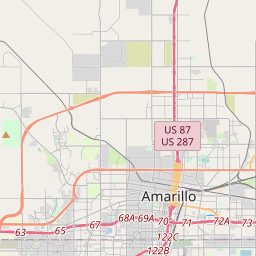Polk Street Schools
Historical marker location:






During the 20th century, Polk Street was home to three public schools. The first opened in 1900 to meet the needs of the rapidly-growing Amarillo community. Bounded by Polk, Tyler, 12th and 13th Streets, the Red Brick School house supplied space for 284 students; the property also had sheds for the horses and donkeys belonging to students coming from ranches. In 1911, a brick building was completed south of the Red Brick School at 1300 Polk Street; it was named Amarillo High School. In 1921, the Red Brick School was razed to make room for a new, larger Amarillo High School, which opened the next year. The 1300 Polk Street building became Central Junior High School; it was later renamed Elizabeth Nixson Junior High School in honor of a former principal.
In 1927, the empty space in Amarillo High School’s u-shape design was filled with a cafeteria, gymnasium and auditorium. Further additions were made in 1951 and 1952. In 1964, Nixson Junior High School was razed; other educational facilities were built on the site. Three years later, Amarillo High School integrated without major incident.
A 1970 fire destroyed the main building’s third floor and the auditorium, and damaged the rest of the structure. Students attended classes in usable rooms and in nearby churches until it was decided to rebuild the high school on Danbury Street. The school board sold the block to Amarillo College, and the building at 1200 Polk was razed. Today, other structures from Nixson Junior High and Amarillo High School are still used. Although the former school buildings on Polk Street are no longer employed in primary and secondary education, the schools’ legacy lies in the vital contributions of the former students in the community, state and nation
As one of the most visible programs of the Texas Historical Commission (THC), historical markers commemorate diverse topics in Texas history, including: the history and architecture of houses, commercial and public buildings, religious congregations, and military sites; events that changed the course of local and state history; and individuals who have made lasting contributions to the state, community organizations, and businesses.
More history nearby
Texas is home to the world's largest bat colony. The Bracken Bat Cave, near San Antonio, is home to millions of Mexican free-tailed bats.
In 1876, Potter County was officially established and named after Robert Potter, a lawyer and signer of the Texas Declaration of Independence. The county's first town, Amarillo, was founded soon after and quickly became the county seat. Initially, Amarillo served as a cattle shipping point and a center for trade, attracting businesses and settlers from surrounding areas.
The early 20th century brought significant development to Potter County. The discovery of oil in nearby areas in the 1920s led to a boom in the county, with oil companies setting up operations and bringing wealth and jobs to the region. This growth and prosperity continued throughout the 20th century, with Amarillo becoming a major economic and cultural hub in the Texas Panhandle.
Today, Potter County continues to thrive as a vibrant community. Its economy is diversified, with significant contributions from industries such as healthcare, education, agriculture, and tourism. The county boasts numerous parks, museums, and attractions, making it an attractive destination for visitors. With its rich history and ongoing growth, Potter County remains a significant contributor to the heritage and economy of Texas.
Potter County Timeline
This timeline provides a glimpse into the major events and milestones that have shaped the history of Potter County, Texas.
- Potter County is formed on August 21, 1876
- In 1886, Amarillo becomes the county seat of Potter County
- The first courthouse in Potter County is built in 1887
- The first oil well is drilled in Potter County in 1921
- Potter County experiences significant growth during the oil boom of the 1920s
- Palo Duro Canyon State Park is established in Potter County in 1934
- In 1951, the Pantex Plant is established in Potter County, becoming a key facility for the assembly and disassembly of nuclear weapons
- The Tri-State Fair & Rodeo, held annually in Potter County, celebrates its 100th anniversary in 2021